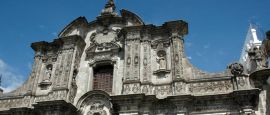Travel to Ecuador
Flying to Ecuador
Ecuador is well connected by air to major cities across the Americas and a selection of European hubs. The main international gateway is Mariscal Sucre International Airport (UIO) in Quito, located in a spacious, modern complex east of the capital. It receives flights from cities such as Bogotá, Lima, Panama City, Miami, Madrid and Amsterdam. Quito serves as a convenient entry point for travellers heading into the Andes or connecting onwards to the Amazon.
José Joaquín de Olmedo International Airport (GYE) in Guayaquil, the most populous city in Ecuador, is another key point of arrival. Situated on the coast, it offers numerous connections across South America and North America, with frequent services to Lima, Santiago, New York, Houston and Miami. Its position makes it especially convenient for visitors continuing to the Galápagos Islands.
International services are operated by a mix of regional and global carriers, including LATAM, Avianca, Copa Airlines, KLM and American Airlines. Flight schedules can vary seasonally, and additional services are sometimes offered during holiday periods or peak tourist seasons.
Travellers bound for the Galápagos Islands must first fly to Quito or Guayaquil, from where daily services connect to Baltra and San Cristóbal. These flights are operated by several airlines and require special entry procedures managed by the Galápagos National Park.
With modern airports, reliable regional links and frequent services to neighbouring countries, Ecuador is readily accessible for visitors planning trips across the Andes, Amazon and the coast.
From London to Quito: 15 hours (including layovers).
Airport guides
Airport Code: UIO. Location: Quito Mariscal Sucre International Airport is located around 18km (12 miles) northeast of central... Money: ATMs are available in the public area of the terminal. Currency exchange is also available in... Read more
Travel by rail
Ecuador currently has no international passenger rail services. There are no railway links from Colombia or Peru, and travellers cannot enter the country by train from neighbouring nations.
Driving to Ecuador
Ecuador can be reached by road from its neighbours, Colombia and Peru. The Pan-American Highway runs through all three countries, providing the main overland route once you are already in South America. The northern crossing at Ipiales–Tulcán and the southern crossings from Peru, including Huaquillas on the coast and La Balsa in the Andes, are the most commonly used by travellers. Border procedures are generally straightforward, though local conditions and waiting times can vary.
International buses operate between Ecuador, Colombia and Peru, offering scheduled services that connect major cities such as Quito, Guayaquil, Lima and Bogotá. These buses vary in comfort levels, with some providing long-distance reclining seats and onboard amenities.
As conditions near remote borders can change, travellers planning an overland journey should check up-to-date travel advice before setting out. With preparation, arriving by road offers a scenic way to enter Ecuador and experience the gradual shift in landscapes across the Andes and coastal plains.
It is important to note that there is no road connection between Central America and South America. The Pan-American Highway breaks at the Darién Gap, a stretch of dense jungle between Panama and Colombia with no drivable route. For this reason, travellers coming from Central or North America must fly into South America before continuing overland.
Getting to Ecuador by boat
Ecuador does not have regular international ferry services, and travellers cannot normally reach the country by sea from neighbouring nations. Cargo vessels and occasional private yachts arrive at ports such as Guayaquil, Manta and Esmeraldas, but these are not standard passenger routes and require advance arrangements and specific permissions.
Cruise ships do visit Ecuador periodically, particularly on itineraries that include the Galápagos Islands or the South American Pacific coast.
Do you have any Feedback about this page?
© 2025 Columbus Travel Media Ltd. All rights reserved. No part of this site may be reproduced without our written permission, click here for information on Columbus Content Solutions.




 You know where
You know where